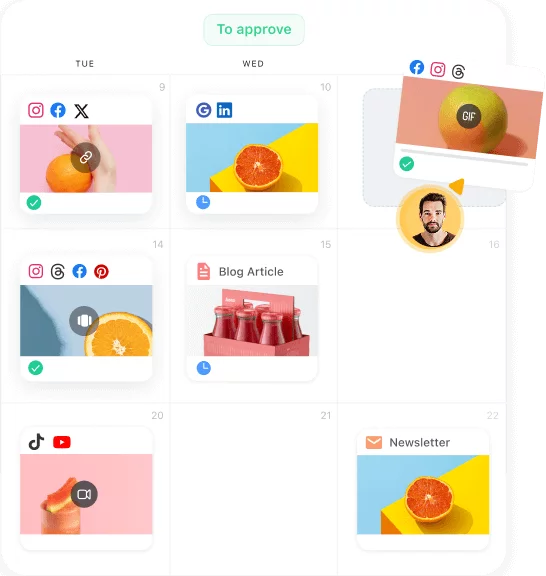Building your brand awareness strategy can be trickier than it seems at first glance. But in today’s highly-competitive business environment, it’s absolutely crucial.
Why? Because having strong brand awareness helps you stand out from the throng. It gives you an edge over the competition and makes sure your company is one of the first your potential customers consider buying from.
In this article, we’ll explore exactly how to go about building a brand awareness campaign that can promote customer loyalty and take your business to the next level.
What is brand awareness?
It’s crucial to draw a distinction between brand awareness and brand recognition – because they’re not quite the same thing. Brand recognition is all about how familiar your brand identity is to potential customers. Do they immediately recognize your brand logo and correctly associate it with your company? That’s good brand recognition.
Brand awareness goes deeper; it incorporates an understanding of your brand values. A high level of brand awareness suggests a stronger connection between the brand and its potential customers.
As an example, let’s consider what marketing analysts Kantar report to be the world’s most valuable brand: Apple. What comes to mind when you see the Apple logo? Sure, you’ll recognize it instantly, but it probably also evokes a constellation of associated thoughts. Maybe you think first of the brand’s sleek, professional design credentials or possibly find yourself reminiscing about your own well-loved iPod from back in the day.
The point is, Apple enjoys very strong brand awareness, which means it’s regularly top-of-mind when people are considering a new tech purchase. This is what makes developing your brand awareness strategy so important, regardless of the field your business operates in.
How to craft a brand awareness campaign
So, what’s the best way of increasing your brand awareness? In essence, it’s all about taking a strategic approach. There are a few key principles that apply, whether you’re running an ecommerce site selling footwear or a B2B-focused startup. Here are six steps to implementing an effective brand awareness campaign.
1. Define and research your target audience
As with any kind of marketing campaign, understanding your target audience comes first. This means more than simply defining a demographic, of course. You need to get into the details of how your target audience thinks.
- Who are they?
- Where can you find them?
- How do they prefer to consume messaging?
- What are their pain points?
Use every method at your disposal to answer these questions: Google Analytics, web-based surveys, and social media polling can all help. Try to develop a comprehensive picture of your potential customers. The objective is to generate genuinely actionable audience insights upon which you can build your brand awareness strategy.
3. Devise an appropriate strategy
Once you have a clear understanding of who your target audience is, you need to decide how to reach them. This stage is a critical one because if you go wrong here, much of what you do afterward could well be wasted.
Draw up a plan that aims at maximizing engagement. How you do this will depend largely on the nature of your business. If you run a chain of restaurants aimed at a young crowd, it makes sense to leverage social media by posting brief clips of tempting, sizzling dishes on Instagram Stories or TikTok.
On the other hand, if you sell a Software as a Service product to businesses, this won’t do. Instead, you should be focusing on B2B SaaS demand generation techniques to build trust over the long term that will help in driving conversions.
In other words, the critical element at this stage is to identify the correct marketing channels to use, as well as to decide how to make the most of them to connect with your target audience effectively.
3. Develop a distinctive brand identity
Your brand identity is the story you sell to your potential customers. It should be cohesive, relevant, and easy to relate to. In addition, it should set you apart from the competition so you stand out in a crowded field.
The most important aspects of brand identity include:
- Visual branding: This is probably the first thing people think of when they hear the word “brand”. Your logos, your brand colors, the fonts you use on your website, on your social media channels like Facebook, TikTok, Instagram etc. – all of these form part of your visual brand identity.
- Brand voice: How do you communicate? Do you project a formal, professional image, or is your brand more suited to a humorous, irreverent touch? Take your cue from your target audience and unify your brand voice to fit their expectations.
- Brand experience: What you do when you engage with your customers matters. For instance, top-quality customer support that goes the extra mile isn’t just good for boosting customer retention. It also contributes positively to your brand identity as a whole.
4. Leverage the power of SEO
Search engine optimization is one of the most powerful tools in your armory when it comes to boosting brand awareness. It’s the best way to increase your visibility, and when it’s done well, you should see a significant increase in organic traffic to your website.
There’s a lot to explain about SEO that goes beyond the scope of this article, but suffice it to say that when your business ranks highly on Google, you benefit from a huge trust dividend. And because trust is the foundation of positive brand awareness, SEO is not something your business can afford to ignore.
Trouble is, everyone else knows this too. Your competitors will be trying to get that top spot in the rankings as well, so beating them to the chase takes real expertise. While you can certainly try to develop your own keyword research, website optimization, and link-building strategies yourself, it’s often better to call in an experienced marketing agency to handle SEO so that you can focus on other business-critical tasks.
5. Create compelling content
A top-notch content creation strategy dovetails with SEO to deliver impact. And the most important thing with content is to produce something genuinely useful. It could be educational or entertaining – as long as it appeals to your target audience, it will boost engagement, which is exactly what you want.
When focusing on increasing brand awareness, it’s a good idea to use value-driven content marketing. That’s to say, all the content you produce should clearly espouse your brand values and communicate them in a straightforward way.
This enables you to build trust and deepen your connection with your target audience. Over time, this approach to content will lead to longer-lasting and more valuable relationships with your customers.
6. Measure and fine-tune
As your brand awareness campaign swings into action, don’t forget to track how effective it is. Setting KPIs and measuring crucial metrics will give you a clear idea of where things are going well, as well as give you clues about how you can adjust your campaign to improve it.
The exact mix of metrics you choose to monitor will depend on your business goals, but a few common ones it’s good to keep an eye on include:
- Page views
- Organic traffic to your site
- Lead generation
- Referrals
- Social media engagement.
Now, it’s tricky to measure brand awareness directly because it’s a partly subjective phenomenon. After all, while you can easily measure brand recognition by showing a test group your logo and asking them whether they recognize it, you can’t see into people’s heads to know how they feel.
That said, metrics like the ones above serve as a useful proxy. As your brand awareness increases, you should see a bump in these figures that’s strongly suggestive your campaign is working.
Top tips for optimizing your brand awareness campaign
There are a few important guidelines to follow when you’re conducting a brand awareness campaign. Nail these, and you’ll be on the right track.
Consistency is key
Being consistent in everything from your visual branding to your tone of voice is essential for projecting a cohesive brand identity. What you’re trying to do is create a personality for your brand that your potential customers understand and can connect with. Make sure all your messaging, from emails to blog posts and landing pages, reinforces that personality every time.
Go where your customers are
Your future customers are out there; you just have to find them and make them aware you can solve their problems. That means reaching out to them where they are and giving them what they need. For instance, a B2B software company should be building a content strategy that aims to increase its authority in its space: white papers, informative video tutorials, and posts offering thought leadership.
Try collaborations
One very productive approach to increasing your reach can be to collaborate with other companies whose target audience overlaps with yours. (Obviously, that doesn’t mean your direct competitors.) Work on opportunities for cross-collaboration that will benefit both parties, and you might just find a whole new audience.
On top of this, consider specialised agencies so you can benefit from their expertise. For example, say you’re a B2B software company. By choosing a specialised marketing agency for SaaS, you can benefit from the knowledge and experience they’ve gained after years of creating effective SaaS-focused campaigns.
Final takeaways
Building a brand awareness strategy takes time. And even once you’ve successfully done it, it needs continuous reinforcement to sustain. This is why taking a systematic approach is key.
With the right mixture of audience research, planning, SEO, and content strategy, you can ensure your business is one of the first names that come to mind when your potential customers are thinking about making a purchase. And that’s great news for the bottom line.
Nick Brown is the founder & CEO of accelerate agency, the SaaS SEO growth agency. Nick has launched several successful online businesses, writes for Forbes, published a book and has grown accelerate from a UK-based agency to a company that now operates across US, APAC and EMEA.






